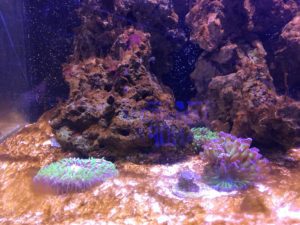Tank algae is essential to the aquarium system
I have been getting so many emails and messages on facebook at the moment about how to deal with pest algae outbreaks that I have decided to dedicate an entire post to this issue!
Algae is not all bad, there are two groups you will encounter in saltwater/freshwater aquariums: pest algae which is micro-algae (meaning small) and beneficial algae which is macro-algae (meaning big).
Macro-algae are marine plants like Caulerpa and encrusting species found on live rock for example, these are good because they add oxygen to the water, are healthy snack foods for fish and suck out toxic nutrients like nitrates and phosphates.
Pest algae on the other hand, is algae we dont want, it can grow over everything and suffocate corals and other sessile invertebrates and makes the aquarium look horrible and unclean. Pest algae examples are hair algae, blue-green algae (cyanobacteria), some coraline algae, bubble algae to name but a few.
Now we have established not all algae is bad, how do we get rid of pest algae?

Nutrification (a science geek word for too much nutrients) is commonly caused by overfeeding (underfeeding is better than overfeeding!) fish food, not doing regular enough partial water changes, perhaps not using a pure enough water source and not vacuuming the bottom of the tank often enough (having no gravel at all makes this easy, a bare glass bottom will rapidly be populated by encrusting live rock organisms anyway). Excess nutrients can also be from adding too much trace elements/vitamins and even be from the type of substrate itself!
Another reason for excessive pest algae is too much natural light, and to a lesser extent too much artificial light. Pest algae outbreaks are favoured by lesser intensity lighting with a longer photoperiod. Old bulbs that have lost their intensity can advantage algae too.
Here are some steps to getting rid of your pest algae once and for all, if you want to find out what is causing your outbreak go through the steps one by one to see which action gets rid of your algae, this will teach you the cause. If you just want it gone, just go nuts! Some and definitely all of these steps will solve your problem of algae control.
-
Do more frequent regular water changes: this will dilute out those pesky, algae feeding nutrients. I recommend 10% every week.
-
Reduce light levels where possible: this is easy if you have a fish-only aquarium, otherwise try and reduce the photoperiod down if possible or replace your bulbs with newer, higher full spectrum aquarium light intensity panels, which are probably the best light for aquarium plants.
-
Use a filtered water source: Tap water can have high amounts of phosphates and nitrates, my water of choice is RO filtered water, this is especially beneficial for reef aquariums. It’s extremely critical to lower how to lower high nitrate levels in fish tank.
-
Get some Live Rock and/or some macro-algae species: Macro-algae will effectively outcompete pest algae by naturally mopping up nutrients before they get to the pest algae causing them to starve YAY! They look cool too…
-
Get some tank janitor algae-busting species: Like Tangs, Turbo & Astrea snails, Sea Urchins, Blennies which will happily mow through algae.
-
Reduce Pollutants: Feed less, make sure you are paying attention to everything you are putting in the water for example trace elements you may not really need.
-
Purchase a protein skimmer: These babies reduce dissolved organics at the source, they work amazingly well when set up correctly, get one!
I hope this article helped to give you some algae fighting options for your saltwater or freshwater aquarium.